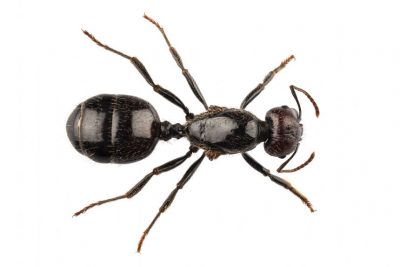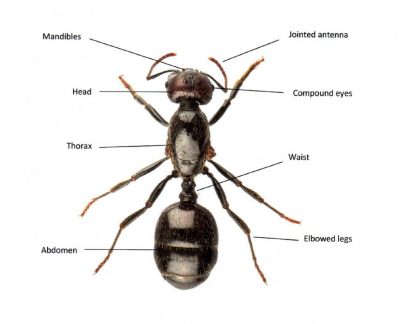Ants


Ants
Anatomy
In relation to their size, ants are extremely strong. They are able to pick up more than 50 times their own body weight. This would be the same as a human picking up a car.
Ants have a tiny waist, which separates the thorax from the abdomen and in comparison to the rest of their body they have very large heads with big jaws, which move sideways to chew. They have six legs, each of which has three joints.
Ants have two stomachs, one to hold food for them to eat themselves, the other they use to share food with other ants. This allows some ants to stay and look after the nest whilst the other ants forage for food.
Ants do not have lungs. They breathe through small holes around their bodies called ‘spiracles’. This helps them to survive underwater for over 24 hours.
Most ants have poor eyesight and communicate by using their antennae. Their antennae have joints like elbows. They use the antennae not only to feel their way but also to smell things. They use their mandibles for holding things, cutting, digging and fighting.
Habitat
Most species of ants live in tropical regions such as the Amazon Rainforest but ants can be found all over the world. They build nests underground, in ground-level mounds known as anthills, or in trees and plants with naturally occurring hollows. Their nests contain hundreds of tunnels and rooms.
Some ants will use their heads to plug tunnel exits to stop intruders getting into the nest.
Diet
Adult ants can not swallow solid food. They chew leaves, crumbs and dead insects into a soft pulp, squeeze out the juice and throw away the remains.
Ants also live off of sap-sucking insects, like aphids. They farm aphids for their nectar by herding the aphids to plants with the best sap and moving them inside when it rains. Studies have shown the ants will clip off the aphids’ wings to prevent them from flying away. The ants stroke the aphids’ backs with their antennae to encourage them to produce honeydew droplets.
Lifecycle
Ants were around with the dinosaurs. An ant lives about 40 – 60 days, although some species can live up to thirty years. Most ants are females. They are called workers. It is their job to look for food, look after the young, clean and defend the nest.
Male ants are called drones and their only function is to mate with the princess. The princess and the drones have wings as mating is usually done during flight and is known as the nuptial flight.
The princess will lose her wings after mating and find a suitable place to nest as the queen of a new colony. The drones die after mating. The queen will lay her eggs and lick them to encourage them to hatch. She feeds the young with her own saliva.
When a queen ant dies the whole colony will usually perish.
Behaviour
Ants are more important than earthworms for turning the soil.
Ants do sleep. They hibernate for around four months in the winter. They also take short naps of about a minute throughout the day. They can have over 250 ‘sleep episodes’ in one day.
When an ant finds a suitable source of food it immediately takes the most direct route back to the nest, leaving a scent trail so other ants can find the food. The ants will travel back and forth along the trail until all the food has gone.
Different Species
There are about thirty-five thousand different species of ant in the world. Some interesting facts about some of the different species are:
• Red ants
Red ants have a stinger, which they use to defend their nest.
• Wood ants
Wood ants do not have a stinger but they are able to squirt acid from the end of their abdomens to protect the nest. These ants can live up to ten years. They make their anthills out of twigs, leaves and soil.
• Army ants
Army ants do not have nests as they are always on the move. They carry their eggs and larvae with them as they march in single-file across long distances.
